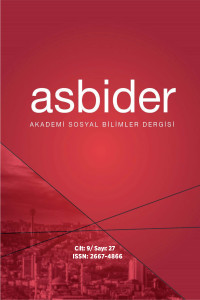Öz
The Convention for the Safeguarding of the Intangible Cultural Heritage (2003) adopted at the 32nd General Conference of UNESCO. The Convention pays importance to the human factor and participation in safeguarding for cultural heritage. It is possible to interpret the subject, which is mentioned as "community, group or individual" in The Convention for the Safeguarding of the Intangible Cultural Heritage and frequently mentioned in the text of the Convention as "the participation of the community, group and individuals", by associating it with the concept of "civil society". The history of the civil society, of course, does not begin with The Convention for the Safeguarding of the Intangible Cultural Heritage. Therefore, it would not be appropriate to interpret the Convention and the issue of participation in a way that is disconnected from the previous texts that emerged in 2003. For this reason, the background of the emergence of the Convention on the axis of the concepts of civil society and participation should be
examined. In this article, the development of the terms civil society and participation are considered together. Therefore, on the axis of parallelism in the origin of the terms civil society and participation, the role of communities, groups and individuals in the Convention has been interpreted together. As a result, it has been seen that the use of the concepts of participation and civil society in the field of cultural heritage and democratization and human rights issues progress in parallel. It is possible to say that the references to participation in the UN conventions constitute the basis of the ICH Convention regarding participation.
Heritage safeguarding has often proceeded in two ways, civil and official. These two dominant protection actors were mutually influenced by ideological, economic, and social policies and shaped each other. This process has been examined in this study in the axis of the development of the concepts of “participation” and “civil society” together with UN and UNESCO conventions and programs.
Anahtar Kelimeler
Kaynakça
- Norton, P., Hughes M. (2018). Public Consultation and Community Involvement in Planning A Twenty-First Century Guide. New York: Routledge.
- Maier, K. (2001). “Citizen Participation in Planning: Climbing a Ladder?”. European Planning Studies, 9(6), 707-719.
- Operational Directives for the Implementation of the Convention for the Safeguarding of the Intangible Heritage-ICH Operational Directives-7.GA-2018. Web:https://ich.unesco.org/en/directives adresinden 16.10.2018 tarihinde alınmıştır.
- Pirenne, H. (2005). Ortaçağ Avrupa’sının Ekonomik ve Sosyal Tarihi. U. Kocabaşoğlu (Çev.), İstanbul: İletişim Yayıncılık.
- Ritzer, G. (2011). Küresel Dünya. İstanbul: Ayrıntı Yayınları.
Öz
UNESCO’nun 32. Genel Konferansında Somut Olmayan Kültürel Mirasın Korunması Sözleşmesi (2003) ilan
edilmiştir. Bu Sözleşme ile kültürel mirasın korunmasında insan faktörüne ve katılıma da ayrı bir önem verilmiştir. Somut Olmayan Kültürel Mirasın Korunması Sözleşmesi’nde “topluluk, grup veya birey” olarak söz
edilen ve “topluluk, grup ve bireylerin katılımı” olarak Sözleşme metninde sıklıkla dile getirilen konuyu “sivil
toplum” kavramı ile ilişkilendirerek yorumlamak mümkündür. Sivil toplum kavramının tarihi elbette Somut
Olmayan Kültürel Mirasın Korunması Sözleşmesi ile başlamaz. Bu anlamda Sözleşmeyi ve katılım konusunu
2003 yılında ortaya çıkmış bir metin olarak okumak ve kendinden önceki metinlerden kopuk bir biçimde
yorumlamak uygun olmayacaktır. Bu nedenle sivil toplum ve katılım kavramları ekseninde Sözleşme’nin ortaya çıkışının arka planı irdelenmelidir. Bu makalede sivil toplum ve katılım terimlerinin gelişimi birlikte düşünülmüştür. Dolaysıyla sivil toplum ve katılım terimlerinin kökenindeki paralellik ekseninde SOKÜM Sözleşmesi’ndeki topluluk, grup ve bireylerin somut olmayan kültürel mirasın korunmasındaki rolü bir arada yorumlanmıştır. Sonuç olarak katılım ve sivil toplum kavramlarının kültürel miras alanında kullanımı ile demokratikleşmenin ve insan haklarıyla ilgili meselelerin paralel bir şekilde ilerlediği görülmüştür. Özellikle de BM sözleşmelerindeki katılımla ilgili atıfların SOKÜM Sözleşmesi’nin katılımla ilgili konuların temellerini oluşturduğunu söylemek mümkündür. Mirasın korunması çoğu zaman, sivil ve resmî olmak üzere iki koldan ilerlemiştir. Bu iki başat koruma aktörü karşılıklı olarak ideolojik, ekonomik, sosyal politikalardan etkilenmiş
ve birbirini biçimlendirmiştir. Bu süreç BM ve UNESCO sözleşmeleri ve programlarıyla birlikte “katılım”, “sivil
toplum” kavramlarının gelişimi ekseninde bu çalışmada incelenmiştir.
Kaynakça
- Norton, P., Hughes M. (2018). Public Consultation and Community Involvement in Planning A Twenty-First Century Guide. New York: Routledge.
- Maier, K. (2001). “Citizen Participation in Planning: Climbing a Ladder?”. European Planning Studies, 9(6), 707-719.
- Operational Directives for the Implementation of the Convention for the Safeguarding of the Intangible Heritage-ICH Operational Directives-7.GA-2018. Web:https://ich.unesco.org/en/directives adresinden 16.10.2018 tarihinde alınmıştır.
- Pirenne, H. (2005). Ortaçağ Avrupa’sının Ekonomik ve Sosyal Tarihi. U. Kocabaşoğlu (Çev.), İstanbul: İletişim Yayıncılık.
- Ritzer, G. (2011). Küresel Dünya. İstanbul: Ayrıntı Yayınları.
Ayrıntılar
| Birincil Dil | Türkçe |
|---|---|
| Bölüm | Makaleler |
| Yazarlar | |
| Yayımlanma Tarihi | 27 Eylül 2022 |
| Kabul Tarihi | 12 Eylül 2022 |
| Yayımlandığı Sayı | Yıl 2022 Cilt: 9 Sayı: 27 |
Kaynak Göster
Akademi Sosyal Bilimler Dergisi Creative Commons Attribution-NonCommercial 4.0 Uluslararası Lisansı ile lisanslanmıştır.



